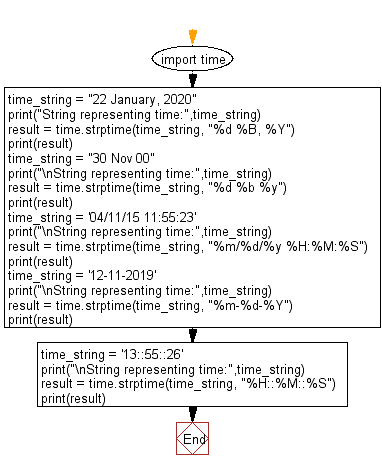Python: Parse a string representing time and returns the structure time
Python Datetime: Exercise-63 with Solution
Write a Python program to parse a string representing time and returns the structure time.
Sample Solution:
Python Code:
import time
time_string = "22 January, 2020"
print("String representing time:",time_string)
result = time.strptime(time_string, "%d %B, %Y")
print(result)
time_string = "30 Nov 00"
print("\nString representing time:",time_string)
result = time.strptime(time_string, "%d %b %y")
print(result)
time_string = '04/11/15 11:55:23'
print("\nString representing time:",time_string)
result = time.strptime(time_string, "%m/%d/%y %H:%M:%S")
print(result)
time_string = '12-11-2019'
print("\nString representing time:",time_string)
result = time.strptime(time_string, "%m-%d-%Y")
print(result)
time_string = '13::55::26'
print("\nString representing time:",time_string)
result = time.strptime(time_string, "%H::%M::%S")
print(result)
Sample Output:
String representing time: 22 January, 2020 time.struct_time(tm_year=2020, tm_mon=1, tm_mday=22, tm_hour=0, tm_min=0, tm_sec=0, tm_wday=2, tm_yday=22, tm_isdst=-1) String representing time: 30 Nov 00 time.struct_time(tm_year=2000, tm_mon=11, tm_mday=30, tm_hour=0, tm_min=0, tm_sec=0, tm_wday=3, tm_yday=335, tm_isdst=-1) String representing time: 04/11/15 11:55:23 time.struct_time(tm_year=2015, tm_mon=4, tm_mday=11, tm_hour=11, tm_min=55, tm_sec=23, tm_wday=5, tm_yday=101, tm_isdst=-1) String representing time: 12-11-2019 time.struct_time(tm_year=2019, tm_mon=12, tm_mday=11, tm_hour=0, tm_min=0, tm_sec=0, tm_wday=2, tm_yday=345, tm_isdst=-1) String representing time: 13::55::26 time.struct_time(tm_year=1900, tm_mon=1, tm_mday=1, tm_hour=13, tm_min=55, tm_sec=26, tm_wday=0, tm_yday=1, tm_isdst=-1)
Flowchart:

Visualize Python code execution:
The following tool visualize what the computer is doing step-by-step as it executes the said program:
Python Code Editor:
Contribute your code and comments through Disqus.
Previous: Write a Python program that takes a tuple containing 9 elements corresponding to structure time as an argument and returns a string representing it.
Next: Python Class exercises
What is the difficulty level of this exercise?
Test your Programming skills with w3resource's quiz.
Python: Tips of the Day
Find current directory and file's directory:
To get the full path to the directory a Python file is contained in, write this in that file:
import os dir_path = os.path.dirname(os.path.realpath(__file__))
(Note that the incantation above won't work if you've already used os.chdir() to change your current working directory, since the value of the __file__ constant is relative to the current working directory and is not changed by an os.chdir() call.)
To get the current working directory use
import os cwd = os.getcwd()
Documentation references for the modules, constants and functions used above:
- The os and os.path modules.
- The __file__ constant
- os.path.realpath(path) (returns "the canonical path of the specified filename, eliminating any symbolic links encountered in the path")
- os.path.dirname(path) (returns "the directory name of pathname path")
- os.getcwd() (returns "a string representing the current working directory")
- os.chdir(path) ("change the current working directory to path")
Ref: https://bit.ly/3fy0R6m
- New Content published on w3resource:
- HTML-CSS Practical: Exercises, Practice, Solution
- Java Regular Expression: Exercises, Practice, Solution
- Scala Programming Exercises, Practice, Solution
- Python Itertools exercises
- Python Numpy exercises
- Python GeoPy Package exercises
- Python Pandas exercises
- Python nltk exercises
- Python BeautifulSoup exercises
- Form Template
- Composer - PHP Package Manager
- PHPUnit - PHP Testing
- Laravel - PHP Framework
- Angular - JavaScript Framework
- Vue - JavaScript Framework
- Jest - JavaScript Testing Framework
